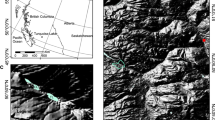Abstract
Five short cores (1.0–1.5 m) representing different depositional zones of an isolated bay of Lake Minnetonka, Minnesota (USA), were independently dated by 210Pb and pollen analysis and were analyzed stratigraphically for elemental chemistry (following sediment fractionation) and sedimentary pigments (including myxoxanthophyll and oscillaxanthin). Because of good dating control, short-interval time-stratigraphic units could be traced across the basin, and lake-wide accumulation rates and concentrations could be estimated. The accumulation and concentration of each component at a core-site relative to basin-wide averages provide new indices, ‘relative accumulation’ and ‘relative concentration’, that are used to evaluate three major processes controlling sediment deposition: (1) the basin-wide flux, (2) the physical redistribution of bulk sediment, and (3) the selective bio-geochemical transport and fossilization of individual sedimentary components within the lake.
Similar content being viewed by others
References
Appleby, P. G. & F. Oldfield, 1983. The assessment of 210Pb data from sites with varying sediment accumulation rates. Hydrobiologia. 103: 29–35.
Battarbee, R. W., 1978. Biostratigraphical evidence for variations in the recent pattern of sediment accumulation in Lough Neagh, N. Ireland. Verh. int. Ver. Limnol. 20: 624–629.
Bradbury, J. P., 1975. Diatom stratigraphy and human settlement in Minnesota. Geological Society of America. Special Paper 171. 74 pp.
Davis, M. B. & M. S. Ford, 1982. Sediment focusing in Mirror Lake, New Hampshire. Limnol. Oceanogr. 27: 137–150.
Davison, W., C. Woof & E. Rigg, 1982. The dynamics of iron and manganese in a seasonally anoxic lake; direct measurement of fluxes using sediment traps. Limnol. Oceanogr. 27: 987–1003.
Dearing, J. A., J. K. Elner & C. M. Happey-Wood, 1981. Recent sediment flux and erosional processes in a Welsh upland lakecatchment based on magnetic susceptibility measurements. Quat. Res. 16: 356–372.
Engstrom, D. R., E. B. Swain & J. C. Kingston, 1985. A paleolimnological record of human disturbance from Harvey's Lake, Vermont: geochemistry, pigments and diatoms. Freshwat. Biol. 15: 261–288.
Engstrom, D. R. & H. E. Wright, Jr., 1984. Chemical stratigraphy of lake sediments as a record of environmental change. In E. Y. Haworth & J. W. G. Lund (eds), Lake Sediments and Environmental History. Leicester University Press. Leicester: 11–67.
Grimm, E. C., 1983. Chronology and dynamics of vegetation change in prairie-woodland region of southern Minnesota, U.S.A. New Phytol. 93: 311–350.
Håkanson, L., 1977. The influence of wind, fetch and water depth in the distribution of sediments in Lake Vänern, Sweden. Can. J. Earth Sci. 14: 397–412.
Hilton, J. & M. M. Gibbs, 1984. The horizontal distribution of major elements and organic matter in the sediment of Esthwaite Water, England. Chem. Geol. 47: 57–83.
Kelts, K. & K. J. Hsü, 1978. Freshwater carbonate sedimentation. In A. Lerman, (ed.), Lakes: Chemistry, Geology, Physics. Springer-Verlag, N.Y.: 295–323.
Lehman, J. T., 1975. Reconstructing the rate of accumulation of lake sediment: the effect of sediment focusing. Quat. Res. 5: 541–550.
Mackereth, F. G. H., 1966. Some chemical observations on postglacial lake sediments. Phil. Trans. r. Soc. London B 250: 165–213.
Megard, R. O., 1972. Phytoplankton, photosynthesis, and phosphorus in Lake Minnetonka. Limnol. Oceanogr. 17: 68–87.
Mortimer, C. H., 1941. The exchange of dissolved substances between mud and water in lakes. J. Ecol. 29: 208–329.
Mortimer, C. H., 1942. The exchange of dissolved substances between mud and water in lakes. J. Ecol. 30: 147–201.
Murchie, S. L., 1985. 210Pb dating and the recent geologic history of Crystal Bay, Lake Minnetonka, Minnesota. Limnol. Oceanogr. 30: 1154–1170.
Sanger, J. E. & E. Gorham, 1972. Stratigraphy of fossil pigments as a guide to the postglacial history of Kirchner Marsh, Minnesota. Limnol. Oceanogr. 17: 840–854.
Swain, E. B., 1985. Measurement and interpretation of sedimentary pigments. Freshwat. Biol. 15: 53–75.
Author information
Authors and Affiliations
Rights and permissions
About this article
Cite this article
Engstrom, D.R., Swain, E.B. The chemistry of lake sediments in time and space. Hydrobiologia 143, 37–44 (1986). https://doi.org/10.1007/BF00026642
Accepted:
Issue Date:
DOI: https://doi.org/10.1007/BF00026642




